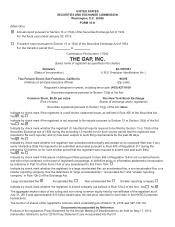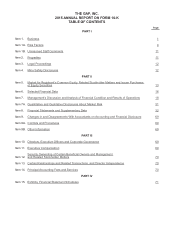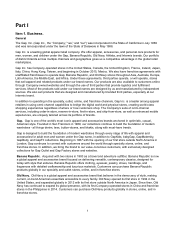Banana Republic 2015 Annual Report Download - page 15
Download and view the complete annual report
Please find page 15 of the 2015 Banana Republic annual report below. You can navigate through the pages in the report by either clicking on the pages listed below, or by using the keyword search tool below to find specific information within the annual report.6
If we are unable to manage our inventory effectively, our gross margins could be adversely affected.
Fluctuations in the global apparel retail markets impact the levels of inventory owned by apparel retailers. The
nature of the global apparel retail business requires us to carry a significant amount of inventory, especially prior
to the peak holiday selling season when we build up our inventory levels. Merchandise usually must be ordered
well in advance of the season and frequently before apparel trends are confirmed by customer purchases. We
must enter into contracts for the purchase and manufacture of merchandise well in advance of the applicable
selling season. As a result, we are vulnerable to demand and pricing shifts and to suboptimal selection and timing
of merchandise purchases. In the past, we have not always predicted our customers’ preferences and acceptance
levels of our trend items with accuracy. If sales do not meet expectations, too much inventory may cause
excessive markdowns and, therefore, lower than planned margins.
We have key strategic initiatives designed to optimize our inventory levels and increase the efficiency and
responsiveness of our supply chain, including vendor fabric platforming, product demand testing, and in-season
rapid response to demand. These initiatives involve significant systems and operational changes and we have
limited experience operating in this manner. If we are unable to implement these initiatives successfully, we may
not realize the return on our investments that we anticipate, and our operating results could be adversely affected.
The failure to attract and retain key personnel, or effectively manage succession, could have an adverse
impact on our results of operations.
Our ability to anticipate and effectively respond to changing apparel trends depends in part on our ability to attract
and retain key personnel in our design, merchandising, marketing, and other functions. In addition, several of our
strategic initiatives, including our technology initiatives and supply chain initiatives require that we hire and/or
develop employees with appropriate experience. Competition for this personnel is intense, and we cannot be sure
that we will be able to attract and retain a sufficient number of qualified personnel in future periods. If we are
unable to retain, attract, and motivate talented employees with the appropriate skill sets, or if changes to our
organizational structure, operating results, or business model adversely affect morale or retention, we may not
achieve our objectives and our results of operations could be adversely impacted. In addition, the loss of one or
more of our key personnel or the inability to effectively identify a suitable successor to a key role could have a
material adverse effect on our business. At the end of fiscal 2014 and beginning of fiscal 2015, there were several
changes made to our senior leadership team, including our Chief Executive Officer; Global President, Gap; and
Global President, Banana Republic. In October 2015, our Global President, Old Navy left the Company, and a
search for a new global brand president is underway. The effectiveness of the new leaders in these roles, and any
further transition as a result of these changes, could have a significant impact on our results of operations.
We are subject to data security risks, which could have an adverse effect on our results of operations and
consumer confidence in our security measures.
As part of our normal operations, we receive and maintain confidential, proprietary, and personally identifiable
information, including credit card information, about our customers, our employees, job applicants, and other third
parties. Our business employs systems and websites that allow for the secure storage and transmission of this
information. However, despite our safeguards and security processes and protections, security breaches could
expose us to a risk of loss or misuse of this information, litigation, and potential liability. The retail industry, in
particular, has been the target of many recent cyber-attacks. We may not have the resources to anticipate or
prevent rapidly evolving types of cyber-attacks. Attacks may be targeted at us, our customers, or others who have
entrusted us with information. In addition, even if we take appropriate measures to safeguard our information
security and privacy environment from security breaches, we could still expose our customers and our business to
risk. Actual or anticipated attacks may disrupt or impair our technology capabilities, and may cause us to incur
increasing costs, including costs to deploy additional personnel and protection technologies, train employees, and
engage third-party experts and consultants. Advances in computer capabilities, new technological discoveries, or
other developments may result in the technology used by us to protect transaction or other data being breached
or compromised. Measures we implement to protect against cyber-attacks may also have the potential to impact
our customers’ shopping experience or decrease activity on our websites by making them more difficult to use.
Data and security breaches can also occur as a result of non-technical issues, including intentional or inadvertent
breach by our employees or by persons with whom we have commercial relationships that result in the
























